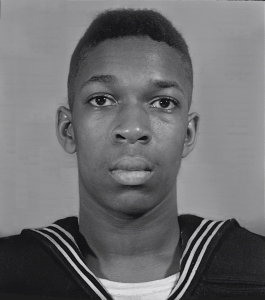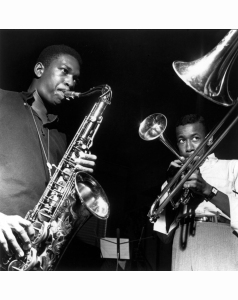By Marty Goodman, Socialist Action, June 22, 2017
“Chasing Trane,” a documentary film by John Scheinfeld.
“Trane is now a scope of feeling. A more fixed traveler, whose wildest onslaughts are gorgeous artifacts not even deaf people should miss.” — Amiri Baraka, poet, jazz critic, and activist
In July 1967, I heard on a late night jazz radio show in Miami that visionary jazz saxophonist John Coltrane had died at the age of 40 of liver cancer. Doom and gloom was the mood, although the host tried his best to assure us that jazz would live on—somehow. Now, 50 years later, a new Coltrane biopic film, “Chasing Trane,” is out. Written and directed by documentarian John Scheinfeld, it is the first film made in cooperation with the Coltrane family.
“Chasing Trane” is jazz retrofitted for the mainstream—that is, mostly white, middle-class jazz fans. But it is an inadequate and misleading introduction for jazz beginners. It is an anti-jazz avant-garde work that simultaneously lionizes an avant-garde icon. There isn’t one complete performance in the entire film, so people cannot judge Coltrane’s adventurous music for themselves. A “Coltrane lite” film was apparently what director Sheinfeld hoped for. Mission accomplished.
Coltrane was a jazz revolutionary, the avant-garde’s leading persona in an era of civil rights and emerging Black nationalism.
To its credit, “Chasing Trane” tells the story of the musician’s early life in Jim Crow North Carolina. As a boy, John was immersed in Black church music; two grandfathers were preachers. As African American Professor Cornell West explained in the film, ”Black music was a Black response to being terrorized and traumatized … that’s Black music, a response to a catastrophe.”
Coltrane was never overtly political, although he did attend a Malcolm X speech on the recommendation of his first wife Naima, a Muslim. But Coltrane was deeply affected by the Black struggle, Dr. King, and, as the film highlights, the 1963 racist bombing of a Black church in Birmingham, Ala., that killed four African American girls. Coltrane dedicated his mournful piece, “Alabama” to the victims, it is said, set to the cadence of an MLK speech.
In those times, Coltrane and the overwhelmingly African American jazz avant-garde were challenging conventional Western music’s structure, melody, and harmony. In particular, the avant-garde became famous for discordant, unconventional honks and angry screams. The music was sometimes overtly political, sometimes spiritual, often a mixture of both or simply neither. What was always clear was that society must change!
The mostly white jazz old-guard pushed back. In 1962, prominent jazz critic Leonard Feather, writing in Downbeat, the leading jazz magazine, called the avant-garde “anti-jazz,” a shot aimed mostly at Coltrane. Even jazz musicians got up and walked out on Coltrane, as did European audiences in hearing the work of early 20th-century modernist classical composers.
Coltrane’s evolution
After the passing of several family members, John took up music. After high school, he joined his family in Philadelphia, where he enlisted in the Navy in 1945 and joined a Navy jazz band. By ’45 he had caught live jazz god Charlie “Bird” Parker, the center of the be-bop revolution. Parker, and his gifted sidemen, trumpeter Dizzy Gillespie and pianist Bud Powell, played a new, fast-paced jazz tempo that was distinctly urban and reflective of postwar Black life. Said Coltrane, “the first time I heard Bird play, it hit me right between the eyes.” John was screaming.

John Coltrane in the U.S. Navy, 1945, when he made his first jazz recordings.
After playing with lesser bands as a would-be Charlie Parker, Coltrane got to play occasionally with his idol Parker in the late ’40s. From 1949-51, Coltrane began traveling with Dizzy Gillespie and then in 1955, with trumpet superstar Miles Davis.
During the 1950s, Coltrane struggled with heroin addiction, as did many jazz musicians. Drugs were glorified by Charlie Parker as a door to creativity. By 1951 Coltrane was booted out of Dizzy Gillespie’s band, and also from Miles Davis’ classic quartet in 1957 (Miles had his own bouts with heroin), and from the band of pioneer bop composer/pianist Thelonious Monk.
Charlie Parker’s drug-ravaged body succumbed in 1955, but Coltrane cold turkeyed on his own. Coltrane was back with Miles in 1958 in time for the all-time classic Miles album, “Kind of Blue” (1959).
But with Miles, Coltrane was feeling a creative impasse. At the risk of oversimplification, Miles represented “cool jazz” to whites, a less threatening alternative to bop and the drug culture of Parker. Trane felt confined artistically and left Miles. In 1958, jazz critic Ira Gitler coined the term “sheets of sound” to describe the unique, evolving Coltrane style as he worked with Miles.

Recording “Blue Train” in Hackensack, N.J., 1957.
In the early 1960s, radical stylists appeared around Coltrane and within the broad avant-garde. The “radicals” (my favorites) included alto sax man Ornette Coleman—on a different path than Coltrane but an anti-establishment hero, particularly after his pivotal “Free Jazz” album (1960). Collaborators with Coltrane were the short-lived experimenter, saxophonist Eric Dolphy; the angry, political tenor sax man, Archie Shepp; the fearless Pharoah Sanders; bombshell innovator Albert Ayler; and pianist Cecil Taylor, whose volcanic style first took shape in the 1950s.
Several of these ground-breaking artists are still alive today—Sanders, Shepp, Coltrane bassist Reggie Workman, and Cecil Taylor. Archie Shepp’s classic first album “Four for Trane” showed Coltrane standing next to him on the cover. Yet Shepp and the others do not speak a word in the film.
A few weeks after the film was released in April, I spoke with David Murray, thought to be the best of the 1970s post-Trane tenors, rooted in Coltrane and the avant-garde. Murray dedicated an album to Coltrane tunes.
Murray was playing at the world famous Village Vanguard with his provocatively named unit “Class Struggle.” I snatched an opportune moment as Murray walked past, sax in hand: “David, quick question. Did they call you for the Coltrane movie?” He answered, “Nope, they went straight to [Wynton] Marsalis!” I shot back, “Why am I not surprised!”
To jazz radicals, trumpeter Marsalis is musical neo-conservatism incarnate, but he appears several times in the movie. Marsalis came into prominence during the Reagan era and is the longtime artistic director of “Jazz at Lincoln Center” in New York. Marsalis has been sharply criticized for his systematic exclusion of today’s talented free-jazz musicians. Marsalis has said, “post-1965 avant-garde playing is outside of jazz,” calling some avant-gardists ‘“charlatans.” That apparently sits well with Lincoln Center’s wealthy funders and cultural Czars.
Also in the film was jazz fan and ex-president Bill Clinton, who represented what Coltrane despised—war, racism, corruption and lies. Clinton, an untalented saxophone player, contributed little other than star power. What is this guy doing here, I asked myself?
Somewhat more palatable was Cornel West, the African American writer and supporter of liberal democrats. But West got with the underlying motif, dissing the avant-garde. West portrayed Coltrane’s late works as indecipherable and ultimately dismissible. “I still don’t understand it,” said West. Okay, but what are you doing in this movie?
Let the music speak for itself!
For those new to Coltrane, his creative highs include: “Giant Steps” (1960), Coltrane playing his own compositions; “My Favorite Things” (1961), a cover of the sappy Broadway tune, radically transformed into a searching, almost eastern sound; “A Love Supreme” (1964), a non-sectarian musical prayer for peace and tolerance that is Coltrane’s most revered album; the daring free-jazz “Ascension” (1965); and “Live at the Village Vanguard Again!” (1966), which includes a soul-stripping solo by Sanders.
In his book, “Black Nationalism and the Revolution in Music” (1970), Frank Kofsky quotes Archie Shepp’s brief but apt description of the music capitalist, “You own the music and we make it.” Kofsky added, “Part of the ownership Shepp refers to includes ownership of the means of mental production,” that is, club owners, the record producers and, of course, jazz filmmakers.
The genius of Coltrane will outlive the cultural mediocrity of late capitalism. Coltrane lives!

No comments:
Post a Comment